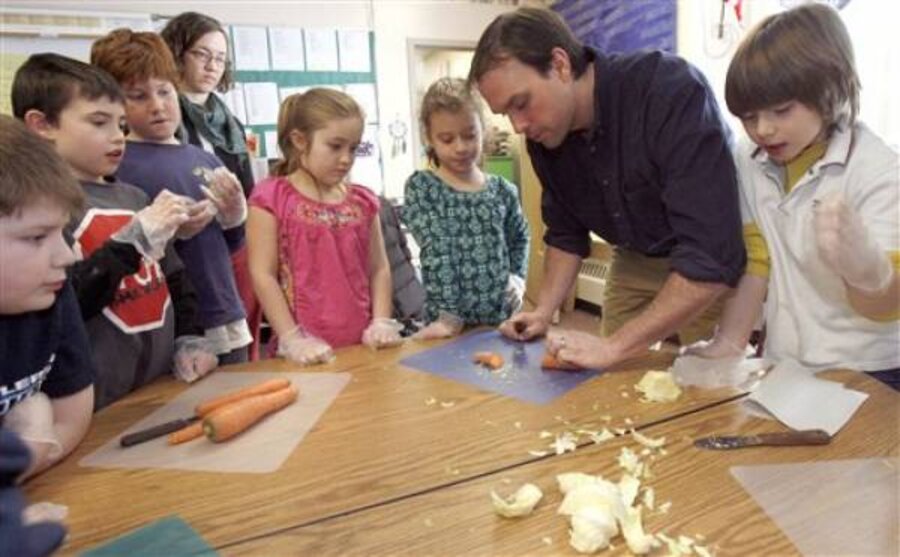Farm to School program has third-graders scrambling to the salad bar
Loading...
| SHARON, Vt.
The third- and fourth-graders at Sharon Elementary know where the veggies in their soup come from because they've visited the farms. They know the nutritional value of the carrots, onions, and cabbage because they've studied them in class, and they know how they're grown because they've nurtured them in raised beds out back.
The 105-student school is part of the National Farm to School Network, aimed at getting healthier meals into school cafeterias, teaching kids about agriculture and nutrition and supporting local farmers.
About 40 states have farm-to-school programs, but Vermont is a leader in incorporating all three missions into its programs.
"Vermont has really taken it on in quite the most holistic way and not just in a couple of school districts but statewide," says Anupama Joshi, director of the Farm to School program, based at the Center for Food and Justice at Occidental College in Los Angeles.
Vermont may be a step ahead of other states because a nonprofit partnership called Vermont FEED had already been working to get local foods into schools.
The state also has backed the farm-to-school effort with funding to help schools buy equipment to chop or process the local food and buy meat from a local farmer.
What started as a handful of pilot programs has grown into 45 Vermont schools getting grants and about 60 with farm-to-school activities. The funding is expected to dry up next year with budget cuts.
Sharon used its $13,500 grant to buy a potato chopper and a food processor. Food service director LinAnn Perry now uses the food processor machine to slice squash and tomatoes picked from the school's gardens and area farms in the summer and fall, later to be frozen. The school also bought a salad bar, which has been a huge hit with the kids.
When Ms. Perry used to prepare salads for the kids, there was a lot of waste. But when kids could choose what they wanted in their bowls or on their plates, more were eating fruits and vegetables, she says.
The number of students buying hot lunch has jumped by 50 percent since the school added the salad bar, Perry says. The salad bar is also used for tacos and stir-fries.
The students take part in lunch room taste tests to see what they like. Harvest soup, also known as cabbage soup, with and without beef, got rave reviews.
"This is great, guys," says sixth grader Daniel Lazar.
The third and fourth graders who chopped up vegetables for the soup also tried to sell other kids on the meal. They hung up posters in the cafeteria that advertised the nutritional value and cancer-fighting properties of the ingredients, which they learned about that morning.
"Super onions say no to cancer," one read.
The students are learning to eat healthier, and the focus on agriculture, local food and nutrition is paying off in the classroom, says principal Barrett Williams.
Kids are interested, and teachers are given more diversity in the curriculum — they can work the food angle in science, reading and health classes, he says.
"That really changes kids' perspectives on the traditional reading, writing, math, science, social studies," Mr. Williams says. "If they can see that they are meeting writing standards through doing a response to their cooking activity that day, you know, that means something to them."
But activities like the farm field trips are what Williams really likes.
"A student who may struggle with a textbook — sitting down and reading text and responding to text — may excel going into a place-based activity," Williams says. "Whether it's visiting a farm or going on some type of field trip and having a hands-on experience, and then being able to respond to that through writing."
Working with local farmers helps build community, he says, although that food may be more expensive than the commodity food that some schools use.
The grant helped to buy at least 200 pounds of ground beef from Back Beyond Farm in Chelsea, which cost about a dollar more per pound than hamburger from an area distributor, Perry says. But Vermont apples are cheaper than apples from other states, she says.
The school has raised money for the program by hosting a winter farmers' market.
"I think it's really good because we get healthier here than at my old school, and we get more fruits and vegetables and local meat," says fourth grader Morgan Jones.
Editor’s note: For more on gardening, see the Monitor’s main gardening page, which offers articles on many gardening topics. Also, check out our lively Diggin' It blog and our RSS feed. You may want to visit Gardening With the Monitor on Flickr. Take part in the discussions and get answers to your gardening questions. If you join the group (it’s free), you can upload your garden photos and enter our contests.





